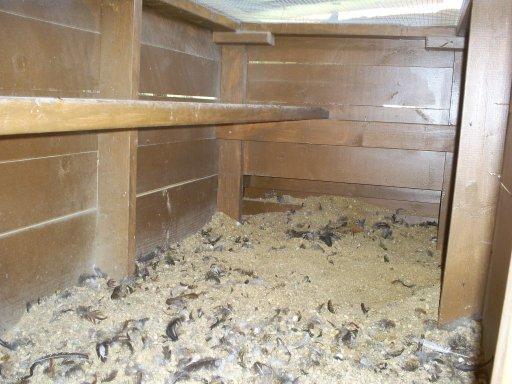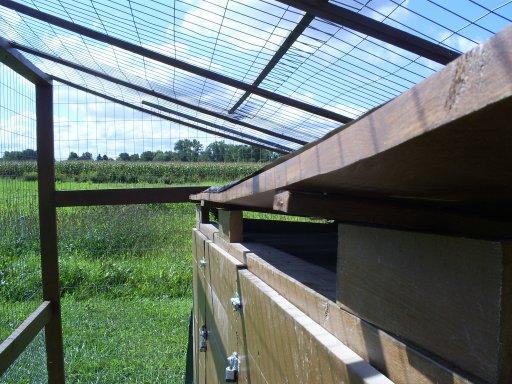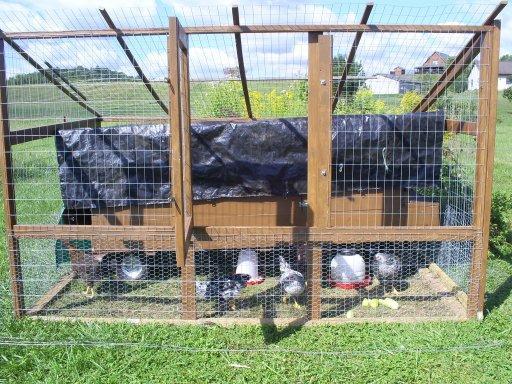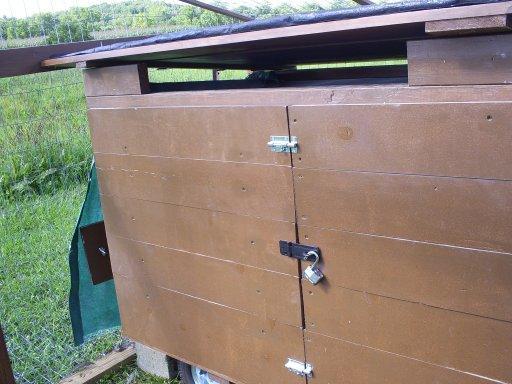- Mar 25, 2009
- 1,299
- 15
- 171
I know there's a lot of this going around, but I think mine's pretty specific, so I'll ask anyway XD
To set things up, here are couple shots of my chicken house, with the ventilation in view (these are clickable thumbnails; they get bigger, so don't ruin your eyes squinting
 ):
):
Interior, you can see how the "ceiling" is hardware wire and open under the entire roof if you look top center. The roost is also visible here, as the board that's center left going to center center. When the hens are standing on it, their heads touch the ceiling, but when they're sleeping, there's about a 6" space between their heads and the wire.

Roof, with blocks under it. The high side is open 3.5" in this picture; if I turn the blocks upright, I can hold it open in its "rain" and "airing" position at about 12". Low side is always open about 1/2", and the blocks can be laid down for a 1.5" opening on the high side, or kicked out altogether for a 1/2" opening all around.

Front, high-side of the roof with the tarp down over the opening. Modification has been made since this picture was taken, and there's now a full tarp that hangs from the roof to the ground on the left side by the pop door to keep rain from blowing in. There is also about a 6" overhang of tarp on the back and right sides. Only the tarp on the front actually touches the sides of the house; the back has about a 2" gap and the sides have about 5" each, so what you kind of end up with are like the under-eave vents on a house.

So here's the question... which combination of tarp up/tarp down/high-side opening will give me enough ventilation while still keeping warm air in with the chickens? We've had a very damp fall, so it's been difficult to keep the moisture down (though there is no visible condensation, so that's good) and Rooster has already had frostbite from a 27 degree night. I think he was an idiot and slept in the nesting box with his comb touching its (outside facing) roof, though, so I don't know for sure if that was a moisture thing or not. Might the best thing for me to do be to put a piece of board or tarp over the wire immediately over the 3' of roost they actually use to keep something of a heat ceiling while leaving the rest unblocked for air and keeping the roof as high as it goes?
To set things up, here are couple shots of my chicken house, with the ventilation in view (these are clickable thumbnails; they get bigger, so don't ruin your eyes squinting

Interior, you can see how the "ceiling" is hardware wire and open under the entire roof if you look top center. The roost is also visible here, as the board that's center left going to center center. When the hens are standing on it, their heads touch the ceiling, but when they're sleeping, there's about a 6" space between their heads and the wire.

Roof, with blocks under it. The high side is open 3.5" in this picture; if I turn the blocks upright, I can hold it open in its "rain" and "airing" position at about 12". Low side is always open about 1/2", and the blocks can be laid down for a 1.5" opening on the high side, or kicked out altogether for a 1/2" opening all around.

Front, high-side of the roof with the tarp down over the opening. Modification has been made since this picture was taken, and there's now a full tarp that hangs from the roof to the ground on the left side by the pop door to keep rain from blowing in. There is also about a 6" overhang of tarp on the back and right sides. Only the tarp on the front actually touches the sides of the house; the back has about a 2" gap and the sides have about 5" each, so what you kind of end up with are like the under-eave vents on a house.

So here's the question... which combination of tarp up/tarp down/high-side opening will give me enough ventilation while still keeping warm air in with the chickens? We've had a very damp fall, so it's been difficult to keep the moisture down (though there is no visible condensation, so that's good) and Rooster has already had frostbite from a 27 degree night. I think he was an idiot and slept in the nesting box with his comb touching its (outside facing) roof, though, so I don't know for sure if that was a moisture thing or not. Might the best thing for me to do be to put a piece of board or tarp over the wire immediately over the 3' of roost they actually use to keep something of a heat ceiling while leaving the rest unblocked for air and keeping the roof as high as it goes?



